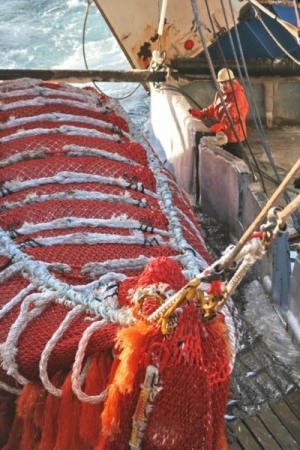
Season A 2018 of Pollock fishery was record-high in terms of the coverage and scope of fishery monitoring activities (total number of observers, processed and analyzed fishing operations, performed biological tests of pollock and by-catch species) compared with preceding years. In total, 23 scientific observers were engaged into monitoring activities during the Pollock fishery in the Sea of Okhotsk in December 2017 – April 2018. All Russian Far East fishery research institutes deployed observers to the fishery (TINRO-Center - 14 observers, KamchatNIRO – 6, MagadanNIRO – 2, SakhalinNIRO – 1).
Observers were based on board of 27 vessels operated by fishing companies (mostly associated with Pollock Catchers Association) engaged in the pollock fishery. The total number of vessels also included 4 trawler-catchers that delivered catch for processing to the mothership where the observer stayed. Two KamchatNIRO observers worked on Danish seiner vessels harvesting for pollock off Kamchatka.
Scientific observation activities by all institutes were focused on the following:
• study of the distribution of pre-spawning and spawning pollock aggregations, identification of the timing of the beginning of mass spawning activities and localization of pollock spawning grounds in fishing subzones of the Sea of Okhotsk in the winter–spring period of 2018;
• monitoring of pollock spawning aggregations in order to track the dynamic of fishing parameters: catch per hour, per haul, per fishing ship-day;
• collection of materials on seasonal and bathymetric variability of pollock size and age structure and gamete maturity;
• estimation of juvenile pollock by-catch in main fishing fleet operating areas;
• qualitative and quantitative assessment of by-catch of other fishes and invertebrates;
• registration of marine mammal and bird capture and death through engagement with fishing gear;
• collection, analysis and submitting of day-to-day information on fishing fleet performance in the pollock fishery to TINRO-Center and the Federal Fisheries Agency.
Scientific observers worked a total of 1312 vessel/days at sea and analyzed 2000 hauls (operations). The observers conducted more than 311,000 size measurements and 15,200 full biological analysis of Pollock species. More than 2200 at-sea observation stations were carried to monitor sea birds and marine mammal accidental by-catch and interaction with the gear.
It can be credibly stated that fishery research institutes have obtained adequate and sufficient volume of scientific information about the dynamics of pollock fishery and catch, its biological characteristics, quantitative and qualitative composition of by-catch species as well as for monitoring of fishery effects on key components of the ecosystem.
More information on Sea of Okhotsk Pollock fishery monitoring in 2018 is available in the reports published at the Publication page.
